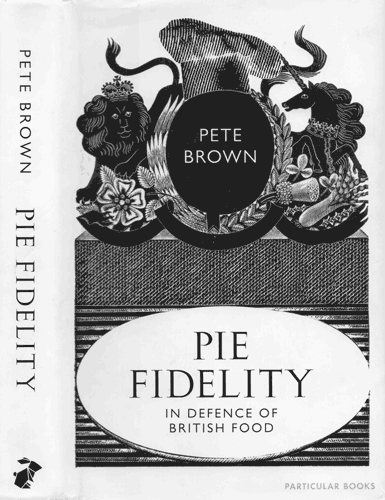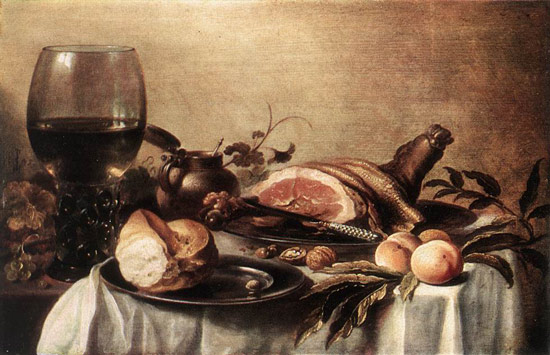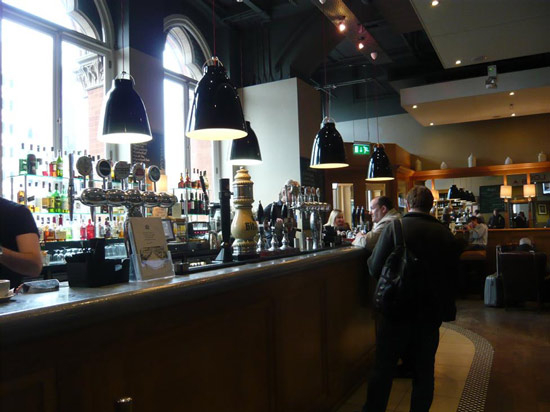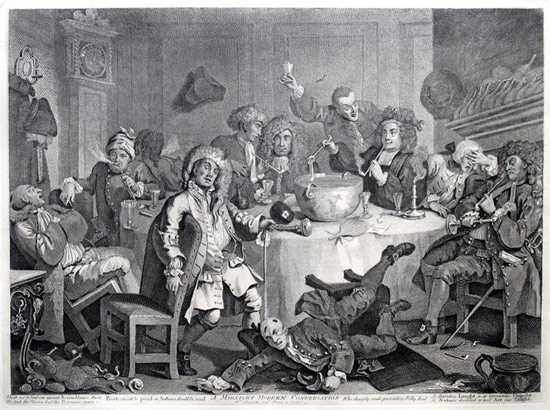Another attempt at assessing the state of British foodways: An assessment of Pie Fidelity by Pete Brown.
Pie Fidelity: In Defence of British Food appeared in Britain this spring (it has not been published in the United States). It is organized according to the dubious premise that a national cuisine may be embodied in nine dishes. Some of them, a cheese sandwich and ‘spag bol’ for examples, are dubious enough representatives in themselves. Inexcusable omissions include savory pies along with the savory and sweet puddings that dominated the British table for over two centuries and survive in strength today.
The often acerbic British press treated its author Pete Brown almost uniformly well, and in some cases with enthusiasm spilling into ecstasy. Favorable reviews appeared across the ideological spectrum in The Guardian, the Daily Mail, The Spectator, The Times and Financial Times. There Tim Hayward, a food writer of some repute, found that Brown’s “prose is engaging, his storytelling effortless” and “his observations… behind all the warm storytelling, so brilliantly accurate.”
Hayward goes further to declare that “Brown’s authority comes from erudition and a novel expertise in product mythology,” that is, the darker arts of advertising that try to assess “the psychological, sociological and demographic data on the consumer” in an effort to convince her she may want something she does not need.

2. Spry writing.
Brown can turn a phrase. On the significance of the Renaissance spice trade:
“Imagine planning a manned trip to Mars because chilli powder was cheaper there and you have some idea of how important spices were to our diet in the fifteenth and sixteenth centuries.” (Brown 203)
In describing the cultural norms of his hometown during the 1970s through the local fish and chip takeaway:
“The shop opened between 12 and 2 p.m., and then again from 4 to 8 p.m., because you’d have to be some kind of freak to eat later than that in the evenings.” (Brown 84)
3. Memories of the Raj.
Brown’s short segment on the origin, evolution and nature of Raj and, later, what the British considered ‘Indian’ cuisine is the highlight of an otherwise wanting chapter on curries and indeed the highlight of Pie Fidelity, although much of it has been illuminated in more detail elsewhere (see, e.g., Burton; Brennan; Collingham; Leong-Salobir; Perkins, “Imperial ecstasies;” Waldrop).
“When the British arrived in India,” he explains, “the cuisine they found wouldn’t have been as alien to them as you might think.” (Brown 203) Mughal and medieval English cooks combined the sweet with savory and seasoned their dishes with high doses of mixed spices. Brown properly observes that the characteristics “of what we now consider to be ‘Indian’ food are an agglomeration of various cuisines in the region, seasoned with significant influences from Europe and south America.” (Brown 202)
As the East India Company extended control over the Indian subcontinent, its cooks “sucked up the different quirks of each region and synthesized them into a new Anglo-Indian sensibility” they called curry. (Brown 204)

As for the legacy of the Raj Brown asserts in a somewhat awkward passage that “[w]ith foods like mulligatawny, kedgeree, chutney and coronation chicken, through the Victorian era curry… achieved widespread acceptance on the tables of polite society.” (Brown 205)
And so, when the first Indian restaurants opened in Britain, their food “had its roots not in the Asian immigrant kitchen but in memories of the Raj. (Brown 209) Then Brown ruins the mood with a sanctimonious, gratuitous critique of imperialism in general and British cultural appropriation in particular.
It is not his only attempt to pander to the aggrieved. In an anachronistic aside, Brown notes that The Whole Duty of a Woman” was “written, perhaps inevitably, by a man…. ” (Brown 296) The manual appeared in 1737, during an era when women were authors of the great majority of household and cookery books, so it is hardly inevitable that the author, identified by Brown as Sir Alexander William George Cassey, would have been male. Nor is it clear whether Cassey wrote The Whole Duty.
Other sources name a different author but that possibility also entails doubt. As Sarah Murden explains, the manual
“ ….appears to have been written from a female perspective although whether it was actually written by a woman seems unclear. In all likelihood, it was written by a man and there appear to be some suggestions that it could have been written by a William Kendrick, but whether correct or not we will never know as the book had no author named.” (Murden)
Brown, who appears to have confined his research on the subject to Wikipedia, recounts none of this nuance.
4. A dissenting voice.
Jonathan Meades, who aspires with some integrity to hate everything, is an outlier among the analysts. His review appeared in The Guardian five days earlier than the favorable one William Skidelsky wrote for the paper. Perhaps the publisher had complained about the first review and an editor feared amends were in order.
Meades describes Pie Fidelity as “this errant, discursive, unedited exercise in bloke-prose and lad-bant,” an “artless book, the silliness of whose title is all too appropriate” and describes Brown himself as “a professional northerner” who “doesn’t let his readers forget it.”
Had Meades chosen to provide examples of sloppiness he would have enjoyed a lot of options. To cite but two, Brown introduces Regula Yesmijn, for the first time at page 27 and as if for the first time at page 322, while grammar presents him with persistent problems. Structure of this kind appears all too often” “There are no books… that says anything…. ” (Brown 63)
Brown celebrates the background he brings to his book and Hayward concurs, but Meades excoriates it. He is worth quoting at length:
“Brown moved from advertising into ‘beer writing’, which is not much of a shift. Beer writing purports to be a branch of consumer journalism. Producer journalism would be more apt. He is forever being invited to judge competitions (beer of course, and cider, veg, pies, cakes, anything). He goes to tastings. He opens food festivals. He attends events.”
Meade believes Brown has been compromised by entry into the realm of symbiotic but shallow celebrity.
“He gets,” Meades goes on,
“to meet the Hairy Bikers! He has lunch with important persons from Foodworld…! The proximity of writer/critic to maker or artisan is worrying. Beer or wine or food writing becomes a sort of dissembled advertising, or advertorial, which doesn’t announce itself save by its gushing enthusiasm and self-congratulation; ‘Few nations have elevated the appreciation and criticism of food and drink as highly as the British.’”
Essence of teenage snogging
This last contention is but one of the unsubstantiated gushes cascading from Pie Fidelity.
The chapter on one dish meets with Meades’ approval, not least because the “first sentence is enviably disgusting: ‘My fondest teenage snogs tasted of fried fish and chips.’” (Meades)
5. A world gone wrong.
He need not have been so kind. The discussion of fish and chips is shallow and breaks no new ground. Notwithstanding those few good passages, for the most part Pie Fidelity is a bad book, badly written and riddled with inaccuracy. Even the bibliography is so slovenly it fails to include most of the sources Brown purports to ‘cite’ in the text. There is no index.
Brown is not even convincing in his self-appointed role as Northern Class Warrior. He reiterates to the point of tedium his resentment at the supercilious attitude of the upper middle and rarefied classes toward people from his avowed social stratum, along with their purported but undocumented disdain for ‘working class’ foods like fish and chips.
It is something of a surprise then that Brown chose to attend the University of St. Andrews, famed as a magnet for not only the urban gentry he claims to despise but also for royalty, aristocracy and wealthy expatriots unable to gain admission to the more prestigious American universities. “Every day I spent at St. Andrews,” he recounts, “felt like a holiday. Even four years didn’t feel like enough. I wanted more.” Judging from the rigor of his research, every day may in fact have been a holiday.
In any event he got his wish, staying on for a fifth year by becoming head of the student agency to organize formals, balls and other blowouts for the swells.
6. Orwell is always with us, or maybe not.
Hayward’s invocation of Orwell demonstrates that in common with Burke or Joyce, Orwell is more cited than read, at least on the subject of food. The same may be said for Brown, at least when it comes to some of his reviewers.
On Orwell, Brown cites an essay entitled “British Cookery” the British Council commissioned him to write during 1946. Brown claims the essay “painted such a glowing picture that the piece was not published… for its intended audience, given the deprivations in Europe.” (Brown 331) The British Council had hoped the essay might lure tourists but, Orwell being Orwell, he subverted its intended purpose.
Among the glowing brushstrokes of “British Cookery;” “Fish in Britain is seldom well cooked;” and “vegetables seldom get the treatment they deserve.” Cabbage is “almost uneatable” and other brassicas are “usually smothered in a tasteless white sauce which is probably the ‘one sauce’ scornfully referred to by Voltaire.”
A few British techniques rise to mediocrity. “British pastry is not outstandingly good” while “British stews and ‘made-up’ dishes… are not particularly distinguished.” Incidentally no British recipe describes a ‘made-up’ dish, although seventeenth and eighteenth century, but not nineteenth or twentieth century sources, refer to ‘made’ dishes. It transpires that Orwell made up his ‘made-up dish.’

Orwell does concede that some puddings are “one of the greatest glories of British cookery,” but only some of them are edible. One
“category of puddings--milk puddings--is the kind of thing that one would prefer to pass over in silence… and they are one of the chief reasons why British cookery has a bad name among foreign visitors.”
They are, Orwell complains, “unfortunately, characteristic of Britain.”
More generally Orwell describes a “heavy… slightly barbarous diet” dependent on “sugar and animal fats” that pairs “sugar with meat in a way that is seldom seen elsewhere,” although he offers no example of these abominations because none exists. (“British Cookery;” Perkins, “Orwell”)
It is apparent from his own reference to Voltaire that Brown has not read “British Cookery.” There, Orwell equates Voltaire’s “one sauce” to white sauce. In Pie Fidelity Brown claims it for meat gravy. Both of them are wrong.
7. A philosphe’s aphorism.
Voltaire was referring to a light sauce similar to Hollandaise (or ‘Dutch’ sauce as it then still was known), “most confusingly” called ‘melted butter,’ that was much in vogue during the eighteenth century. Voltaire liked it. “Though excellent it is completely forgotten,” not least by Orwell and Brown, and no less a luminary than Jane Grigson (who does not appear in Brown’s bibliography) plumped for its revival late in the twentieth century. (Perkins, “‘Melted butter;’” Hutchins 86; Grigson 352; Perkins, “Orwell”)
8. Who reads what?
Notwithstanding his unfamiliarity with the text of Orwell’s essays on British food, Brown chose the title of another one, from the 1945 Evening Standard, as the subtitle for his own book. The choice entails an unintended irony. “In Defence of English Cooking” makes the claim, among other things, that “you practically don’t find good English cooking outside a private house,” hardly a clarion call to the culinarily deprived from abroad.
On Brown, the unidentified reviewer at the (London) Daily Mail is particularly egregious.
“The restaurant Al Frash in Birmingham’s Balti triangle is his destination for a spectacular and scale-buckling vindaloo, and his description of his meal had me reaching for my local takeaway menu before I finished the chapter.” (Daily Mail)
Brown, however, describes a ‘vindaloo’ that is nothing of the sort. Instead it is, as a waiter explains to him, the restaurant’s universal sauce from “pan number three with extra chillies” that unequivocally is “not a vindaloo.”
9. Another question of authenticity.
The faux vindaloo is so spectacular that, as Brown claims in his inimitable prose,
“[i]t’s a motherfucker is what it is…. I… start dribbling from the corners of my mouth because my jaw muscles have gone numb…. The lava in my mouth burns through the last sinews surrounding it and my jaw falls off, uselessly, and disintegrates as it hits the table.” (Brown 230)
Only a macho pseud would eat such a transgressor. Perhaps the Daily Mail columnist falls into the category, or perhaps his local takeaway menu distracted him from reading the entire chapter.
Post “vindaloo”.
He cannot have read the last one in Pie Fidelity because the Mail correspondent writes that the “book ends, as it should, with a traditional Sunday roast.” Perhaps it should have ended that way, but in fact it ends with a chapter, wan as it is, on, of all things, crumble. Not an iconic steamed pudding, pie, trifle, Eton mess or summer pudding, but crumble.
10. Unwarranted assumptions.
This, however, is small beer compared to Brown’s errors. The chapter on the sandwich begins with an unwarranted assumption that people
‘had been eating bread, and putting things on it, and the idea that no one else had ever considered putting an extra slice on top before Montagu is ludicrous.”
Montagu was the Fourth Earl Sandwich, credited with creation of his namesake food. He was particularly fond of salt beef sandwiches. (Rodger 79) “The only source for this origin story,” Brown maintains,
“is Pierre-Jean Grosley, a French historian and travel writer who published a series of not entirely serious portraits of London life in 1770.” (Brown 66)
Other writers, including luminaries like Bee Wilson and Simon Schama, have taken a similar tack to reject the origin story that credits Montagu for the sandwich, although most of them have offered more than mere disbelief.
Wilson argues that something she considers so “obvious” as a sandwich must have existed since time immemorial. She hammers the point as if she is not quite convinced, accumulating interrelated assumptions: “Common sense tells us that the thing itself… must be one of the oldest and most universal types of meal…;” “So the earl gets credited with inventing something that must have been around for hundreds if not thousands of years;” “Workers did not need to give this snack a name;” “There is clearly something comically absurd in giving the sandwich a single point of origin, as if it were a light bulb or a spinning jenny;” “The earl cannot have been the first….;” “Many people must have combined cheese and bread into a ‘sandwich.’” (Wilson 16, 18, 19, 25, 31)
Anybody who does not suffer intellectual whiplash from the lavish repetition of ‘surely,’ ‘must be,’ ‘must have been, ‘clearly, ‘cannot have been’ and the like is not paying attention. (Perkins, “Montagu”)

11. Artificial antecedents.
Wilson does cite an ancient Jewish religious ritual, the Korech, when the faithful consumed something resembling a pita wrap, as evidence of an early sandwich but immediately proceeds to contradict herself. “Middle Eastern wraps,” she admits, “have a lineage which is entirely separate from the European sandwich.” She might have added that they do not look like sandwiches and lack a single name to unify them. (Wilson 26-30; Perkins, “Montagu”))
Schama, notwithstanding Wilson’s characterization of his position, does not quite claim the belegede broodje for the Dutch as the first sandwich in The Embarrassment of Riches. Schama may come close but will not go so far: The “famous belegede broodje” boasts, he says, “greater antiquity than the sandwich,” which is not quite the same thing as saying it was a sandwich. (Schama 152; Perkins, “Montagu”))
Schama’s only reference for the broodje is from a travel book by John Ray published in 1673, which however does not describe any such thing. Instead, Ray refers to what Schama describes as the ‘startling’ and ‘strange habit in taverns of hung beef swinging from the rafters” which, Ray wrote, “they cut into slices and eat with bread and butter laying the slices upon the butter.”
Possibly impairing his credibility, Ray also claims the Dutch ate a “Green cheese said to be coloured with the juice of Sheep’s dung” the same way. (Schama 152; Perkins, “Montagu”)) In any event the broodje, if that is what it was, neither appeared readymade for its diner nor sandwiched the beef or fecal cheeses between slices of bread. No lid; no sandwich.
Wilson also would like to believe that the Dutch ate sandwiches during the seventeenth century, arguing that still lifes depicting food--cheese, bread and herring in one painting; ham, a roll and mustard in another; another roll and “a dish of tiny pink prawns” in a third--each amounts to an “invitation to sandwich-making.” (Wilson 33; Perkins, “Montagu”)
Dutch artists of this ‘golden age’ did not hesitate to depict any culinary item, but none of them produced the image of a sandwich. Neither does any other representational art form before the appearance of the word in print. It would appear that nobody accepted the painterly invitation.
None of this causes Wilson a qualm because, she explains, “this lack of evidence is not evidence that sandwiches were not eaten.” (Wilson 32) Usually, however, an absence of evidence indicates evidence of absence.

English is an inventive, prolix and promiscuous language. It therefore is difficult to believe that no word, let alone multiple words (banh mi, bap, burger, butty, caprisi, cheesesteak, croquet-madame, croquet monsieur, dagwood, grinder, hero, hoagie, Italian, monte cristo, muffaletta, panini, po’ boy, sandwich, sarnie, slider, sub, toastie, wedge… ) existed for centuries to describe what would become so commonplace an item.
The argument employed by Brown, Wilson and others is no different from insisting that Native Americans had an alphabet, the wheel, the sail and alcoholic drinks. These things seem commonplace enough and would have been familiar to Europeans for well over a millennium by the time they reached the Americas. Until then each was unknown to Native Americans.
Historical assumptions based on ‘common sense’ all too often prove unwarranted. Curry is timelessly Indian (It is a British creation.) and relies on ingredients like chiles, potatoes and tomatoes; they therefore must be indigenous to the subcontinent (They are not.).
By another analogy, a number of other preparations now considered iconic do not in reality go back too far. English ‘classics’ like Beef Wellington, or steak and kidney pudding and pie, date only to the middle of the nineteenth century. (Perkins, “Montagu”)
12. The evidence unfolds.
Aside from speculation, we do know a number of things in addition to the Grosley passage about Sandwich himself and the origin of the culinary version of his title, or at least its first use in print. That occurred in 1762, and the writer was no less than Edward Gibbon. This is part of his journal entry from 24 November of that year:
“I dined at the Cocoa Tree…. That respectable body affords every evening a sight truly English. Twenty or thirty of the first men in the kingdom… supping at little tables… upon a bit of cold meat, or a sandwich.”
An acute observer, distinguished historian, Member of Parliament, political commentator and bon vivant mingles with members of the British elite. They are eating sandwiches. Gibbon is hardly a chronicler of the prosaic, and if he considered the practice ‘truly English’ we may take him at his word.
The practice was novel--eighteenth century British trends started at the top of society--and uniquely British. We would find nothing truly English, American or French about eating sandwiches today; the practice is universal. In 1762, however, it was not, so it attracted the attention of Gibbon.
He uses ‘sandwich’ as if familiar with the term, but also as if his reader may not be acquainted with it; another indication of novelty. The diners at the Cocoa Tree were not eating something for Korech or pita wraps. They have, however, filled their sandwiches with “cold meat,” another link to Montagu. (Perkins, “Montagu”)
Brown cites N.A.M. Rodger (but with no page number and as ‘Nicholas Rodger,’ not his usual authorial identity) with approval for the proposition Montagu asked for a sandwich to work without interruption at his desk rather than to gamble through the night as the lore would have it. Rodger is the leading authority on Montagu and the Royal Navy he served as First Lord of the Admiralty for eighteen eventful years during the eighteenth century.
Brown apparently did not read much of the work he cites because Rodger is unequivocal: “There is no doubt,” he believes, that Montagu “was the real author of the sandwich, in its original form…. ” (Rodger 79)
The first instruction for making sandwiches, by Charlotte Mason in her Lady’s Assistant for Regulating and Supplying the Table, did not appear until over a decade after Gibbon noticed them at the Cocoa Tree.
Rough night at the club.
By 1781 Burke had included the word in his correspondence but no recipe or other description appeared in a North American publication until 1837, when Philadelphia author Eliza Leslie described ham sandwiches, which she needed to explain are “used at supper, or at luncheon,” an indication that her readers were not familiar with the item. (Rodger 343n87; Mariani 283; Leslie facsimile 123; Perkins, Montagu”)
Leslie was the advanced scout for the sandwich in the United States; nobody else appears to mention one until 1844, “but it was not until much later in the century, when soft white bread loaves became a staple of the American diet, that the sandwich became very popular and serviceable.” (Perkins, “Montagu;” Mariani 283)
Leslie herself professed to be a patriot, but although she did include a very few distinctly American recipes in her Directions for Cookery in its Various Branches, the Directions appear overwhelmingly British, “many of them very close in wording to older English cookbooks.” (Szathmary vii) The sandwich, it appears, remained Gibbon’s “truly English” artifact for decades.
Given these markers, coupled with the absence of evidence in manuscript, painting or print, it is difficult to give credence to the incredulous critics who dismiss the ingenuity of Montagu.
13. Another Spry moment, among other errors.
In addition to the historiographical errors, an entire species of factual infelicities inhabits Pie Fidelity. Marco Polo, who never visited Britain, did not introduce rhubarb to the archipelago. Bass is a pale ale, not an IPA; American pale ales are not monolithically bright and hoppy. Coronation chicken is not a product of “the Victorian era;” Constance Spry created it in 1953 to celebrate the ascension of Elizabeth II.
Some falsehoods appear intentional. Brown says if he were a traveler from abroad he “would feel cheated” by the dearth of British food on disembarking from his train at the restored St Pancras railway terminal.
He complains of “French patisseries and boulangeries, a champagne bar and sandwich chain…. Look further afield and you’ll find a sushi bar, an American burger joint and an Italian restaurant. When you do eventually find the Betjeman Arms pub, finally there’s a range of classic British dishes, but they’re served in an environment that feels more like a French brasserie than a traditional British pub.” (Brown 32)
The Betjamin Arms, however, describes itself as “the last pub before Paris or the first back in Blighty” and looks the part.

In addition to coffee shops, takeout booths and a satellite of that most British grocer, Fortnum & Mason, thirteen restaurants and bars inhabit St Pancras. The single patisserie is a vaguely French cake shop that also serves traditional British afternoon tea, while the Pain Quotidian branch offers food of many nations including “British Steak & West Country Ale Stew,” a Devon ham & Cheddar tart, and smoked salmon.
Of the remaining eleven, the Barrel Vault “provides a variety of real ales, craft beers, gins, coffees and breakfasts, as well as British pub food classics;” the Booking Office cooks “fresh English fare” for “classic English dining;” The Gilbert Scott, the formal flagship restaurant at the terminal, serves “classic British dishes” including the Sunday roast that Brown reveres; and while the St Pancras Brasserie calls itself such, it too offers its diners “traditional British fare.” (stpancras.com)
While Brown claims the Betjamin Arms stands a lonely vigil, five of the thirteen restaurants at St Pancras in cosmopolitan London specialize in British cuisine, three more than any other nationality, and two of the international outlets also offer some British options.
14. The trouble with Italy.
Britain is not the only blind spot. In his discussion of what the British call ‘spag bol,’ or spaghetti Bolognese, Brown betrays a fundamental ignorance of Italian foodways. As a result his interior colloquy debating its authenticity is rendered irrelevant because he addresses the sole question whether what the British cook is Bolognese rather than Italian. Furthermore his ‘discussion,’ such at it is, devolves into the false choice between food that is authentic as opposed to food that is, a ghastly term, “nice.”
What the British call Bolognese sauce is recognizably a Tuscan sugo de carne built as it is slowly from a base of what Brown calls soffritto but Giuliano Bugialli describes as a battuto.
Each refers to minced carrot, celery, onion and parsley. The vegetables are fried gold in olive oil with finely chopped beef, pork or the two in combination and sometimes mushrooms. Stock goes into the skillet, gets a severe reduction, then wine gets the same treatment before the addition of tomatoes to simmer slowly for hours. (see, e.g., Bugialli 72-73) British Bolognese, then, is misnamed but not inauthentic.
15. Inscrutable scrivenings.
Some passages from Pie Fidelity are simply inane. “The cultural norm today,” Brown maintains based on nothing, “is that we’re expected to buy our sandwiches pre-made and prepackaged.” (Brown 69) Who imposes that purported norm? Who expects anyone to behave that way? People choose convenience on the fly when it comes to a sandwich. They do not buckle to an imposed expectation.
And for Brown, sandwiches have psychological profiles: The cheese sandwich that he repeatedly describes as ‘the sandwich in the sandwich shop called the Sandwich Shop in Sandwich’ has “neither insecurities nor delusions of grandeur.” (Brown 77, 80) The juvenile jokiness of Pie Fidelity has by this point become tiresome.
Whole regions get emotional at times. In an unwelcome foray into the anachronism of universality, Brown declares: “At the end of the nineteenth century, rural France was angry.” (Brown 17)
Perhaps the problem of the Sunday lunch in Britain perplexed all of French agriculture. Brown believes it has caused stress in relations between the two countries:
“Sunday roast is a summation of what it means to be British, of our land, our history, our outlook and attitudes and our eternally weird relationship with the French.” (Brown 319)
Perhaps an imaginary France finds no common ground with an imagined Britain. Brown draws the imagined contrast. “This,” meaning Britain, “is,” in Brown’s nuanced judgment, “a practical, industrious country, not an artistic one.” (Brown 322)
Except, maybe, for curry, or maybe gravy? Brown conflates and extolls their uniquely British artistry.” “Curry,” he explains, “goes one step farther than the other meat/bread meals in its appeal, by pulling off a perfect union of meat, bread and gravy. British curries are wetter than Indian ones…. Bread and gravy is the most British thing in the world…. ” (Brown 214; emphasis in original) There really is nothing to say about any of this.
16. Just say no.
All those positive reviews call into question the work ethic of their authors. Hayward for one summarizes Brown’s work in effusive vein:
“The historical information he weaves around the food is plentiful, accurate and worn lightly, and his observations are fresh and provocative. Brown clearly feels the dishes we are so familiar with, particularly those that have sprung from working-class enthusiasm, are sidelined, forgotten and in need of championing. It is a belief shared with Orwell.” (Hayward)
Hayward is an engaging restaurant critic and competent culinary author. Has he read Pie Fidelity? Given all the errors, infelicities and stale tropes that mar Pie Fidelity it is difficult to imagine he read much of it. Other readers may, however, follow suit without guilt.
Sources:
Anon., “Pie Fidelity,” The Daily Mail (6 April 2019)
Anon., https://stpancras.com/shops-and-dining/dining (accessed 21 July 2019)
Jennifer Brennan, Curries and Bugles: A Memoir and a Cookbook of the British Raj (1990)
Giuliano Bugialli, The Fine Art of Italian Cooking (New York 1977)
David Burton, The Raj at Table (London 1993)
Lizzie Collingham, Curry: A biography (London 2005)
Jane Grigson, English Food (London 1974)
P. J. Grosley, (tr. T. Nugent), A Tour to London; or New Observations on England and its Inhabitants vol. I (London 1772)
Tim Hayward, “Pie Fidelity: In Defence of British Food by Pete Brown--Britain on a plate,” The Financial Times (5 April 2019)
Michael Henderson, “Pie fidelity: In Defence of British Food by Pete Brown review--In praise of the ‘full English,” The Times (23 March 2019)
Sheila Hutchins, English Recipes and others (London 1967)
Cecilia Leong-Salobir, food Cultures in Colonial Asia: A taste of empire (London 2011)
Eliza Leslie, Directions for Cookery in its Various Branches (Philadelphia 1837)
John Mariani, Encyclopedia of American Food and Drink (New York 1999)
Charlotte Mason, The Lady’s Assistant for Regulating and Supplying the Table (London 1773)
Mark Mason, “Is British food really still wodges of stodge?” The Spectator (April 2019)
Jonathan Meades, “Pie Fidelity by Pete Brown review--in defence of British food, The Guardian (27 March 2019)
Mark Morton, “Bread and Meat for God’s Sake,” Gastronomica vol. 4 no. 3 (Summer 2004)
Sarah Murden, “’The Whole Duty of a Woman’ in 1737,” All Things Georgian, https://georgianera.wordpress.com/2014/10/05/the-whole-duty-of-a-woman-in-1737/ (accessed 22 July 2019)
George Orwell, “British Cooking” (unpubl. Ms. 1946; available at www.theorwellprize.co.uk)
“In Defence of English Cooking,” London Evening Standard (15 December 1945)
Blake Perkins, “George Orwell and the Defence of English Food,” Petits Propos Culinaires 101 (October 2014) 68-86
“In defense of John Montagu, creator of the sandwich & so much more,” www.britishfoodinamerica.com no. 49 (Summer 2016)
“‘Melted butter:’ A misnomer and once The Only Sauce,” www.britishfoodinamerica.com no. 25 (February 2012)
William Skidelsky, “Pie Fidelity: In defence of British Food review--no need to scoff,” The Guardian (1 April 2019)
N. A. M. Rodger, The Insatiable Earl: A Life of John Montagu, 4th Earl of Sandwich (New York 1984)
Simon Schama, The Embarrassment of Riches (Berkeley 1988)
Louis Szathmary, “Introduction and Suggested Recipes,” to Leslie, Directions for Cookery (Arno Press facsimile, New York 2010)
Darlene Waldrop, A Curried Gaze: The British Ownership of Curry (unpubl. Masters thesis Athens GA 2007)
Bee Wilson, Sandwich: A Global History (London 2010)




